
Sands of Iwo Jima is a 1949 war film starring John Wayne that follows a group of United States Marines from training to the Battle of Iwo Jima during World War II. The film, which also features John Agar, Adele Mara and Forrest Tucker, was written by Harry Brown and James Edward Grant, and directed by Allan Dwan. The picture was a Republic Pictures production.

Ira Hamilton Hayes was an Akimel O'odham Indigenous American and a United States Marine during World War II. Hayes was an enrolled member of the Gila River Indian Community, located in Pinal and Maricopa counties in Arizona. He enlisted in the United States Marine Corps Reserve on August 26, 1942, and, after recruit training, volunteered to become a Paramarine. He fought in the Bougainville and Iwo Jima campaigns in the Pacific War.
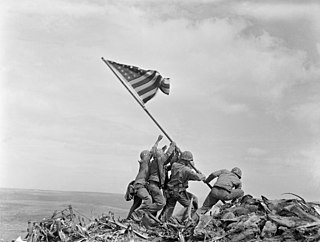
Raising the Flag on Iwo Jima is an iconic photograph of six United States Marines raising the U.S. flag atop Mount Suribachi during the Battle of Iwo Jima in the final stages of the Pacific War. Taken by Joe Rosenthal of the Associated Press on February 23, 1945, the photograph was published in Sunday newspapers two days later and reprinted in thousands of publications. It won the 1945 Pulitzer Prize for Photography and has come to be regarded in the United States as one of the most recognizable images of World War II.

René Arthur Gagnon was a United States Marine Corps corporal who participated in the Battle of Iwo Jima during World War II.
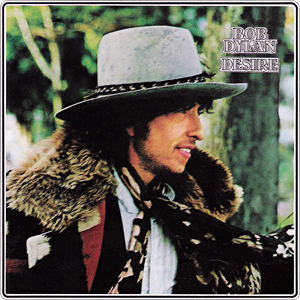
Desire is the seventeenth studio album by American singer-songwriter Bob Dylan, released on January 5, 1976, through Columbia Records. It is one of Dylan's most collaborative efforts, featuring the same caravan of musicians as the acclaimed Rolling Thunder Revue tours the previous year. Many of the songs also featured backing vocals by Emmylou Harris and Ronee Blakley. Most of the album was co-written by Jacques Levy, and is composed of lengthy story-songs, two of which quickly generated controversy: the 11-minute-long "Joey", which is seen as glorifying the violent gangster "Crazy Joey" Gallo, and "Hurricane", the opening track that tells a passionate account of the murder case against boxer Rubin Carter, who the song asserts was framed. Carter was released in 1985, after a judge overturned his conviction on appeal.

Dylan is the thirteenth studio album by American singer-songwriter Bob Dylan, which is made up of outtakes he recorded for earlier albums. Columbia Records compiled it with no input from Dylan and released it on November 16, 1973. The album followed the artist's departure from Columbia for Asylum Records, and the announcement of his first major tour since 1966. In Europe the album was re-released in January 1991 with the title Dylan .
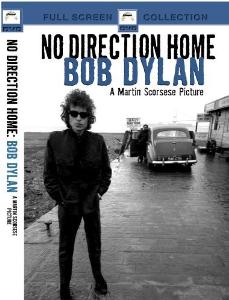
No Direction Home: Bob Dylan is a 2005 documentary film by Martin Scorsese that traces the life of Bob Dylan, and his impact on 20th-century American popular music and culture. The film focuses on the period between Dylan's arrival in New York in January 1961 and his "retirement" from touring following his motorcycle accident in July 1966. This period encapsulates Dylan's rise to fame as a folk singer and songwriter where he became the center of a cultural and musical upheaval, and continues through the electric controversy surrounding his move to a rock style of music.

Flags of Our Fathers is a 2006 American war drama film directed, co-produced, and scored by Clint Eastwood and written by William Broyles Jr. and Paul Haggis. It is based on the 2000 book of the same name written by James Bradley and Ron Powers about the 1945 Battle of Iwo Jima, the five Marines and one Navy corpsman who were involved in raising the flag on Iwo Jima, and the after effects of that event on their lives. Taken from the American viewpoint of the Battle of Iwo Jima, the film is a companion piece to Eastwood's Letters from Iwo Jima, which depicts the same battle from the Japanese viewpoint; the two films were shot back to back.
Peter La Farge was an American singer–songwriter.

Bitter Tears: Ballads of the American Indian is a 1964 concept album, the twentieth album released by singer Johnny Cash on Columbia Records. It is one of several Americana records by Cash. This one focuses on the history of Native Americans in the United States and their problems. Cash believed that his ancestry included Cherokee, which partly inspired his work on this recording. The songs in this album address the harsh and unfair treatment of the indigenous peoples of North America by Europeans in the United States. Two deal with 20th-century issues affecting the Seneca and Pima peoples. It was considered controversial and was rejected by some radio stations and fans.

Orange Blossom Special is the 21st album released by musician Johnny Cash on Columbia Records in 1965. The recordings include country and folk standards, such as "The Long Black Veil", "When It's Springtime in Alaska", "Danny Boy" and "Wildwood Flower".
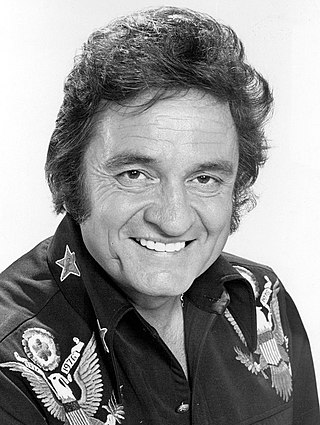
John R. Cash was an American country singer-songwriter. Most of Cash's music contains themes of sorrow, moral tribulation, and redemption, especially songs from the later stages of his career. He was known for his deep, calm, bass-baritone voice, the distinctive sound of his backing band, The Tennessee Three, that was characterized by its train-like chugging guitar rhythms, a rebelliousness coupled with an increasingly somber and humble demeanor, and his free prison concerts. Cash wore a trademark all-black stage wardrobe, which earned him the nickname as the "Man in Black".
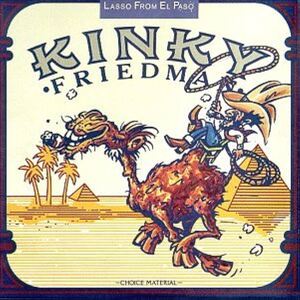
Lasso from El Paso is an album by Kinky Friedman, released in 1976. "Sold American" was recorded live while on tour with Bob Dylan's Rolling Thunder Revue. It was Friedman's last album of original material for more than 40 years.

Roadsongs is a live album of cover songs released by folk/country singer–songwriter Townes Van Zandt in 1994.
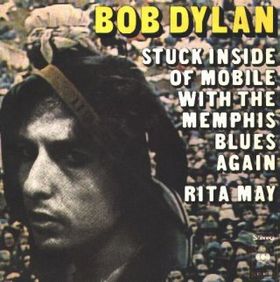
"Rita May" is a song by Bob Dylan, originally recorded during the sessions for the album Desire, but released only as the B-side of a single and on the compilation album, Masterpieces. The song is based on the 1957 rockabilly song "Bertha Lou". Some listeners believe that the lyrics of the song refer to writer Rita Mae Brown, who had complained of the lack of opportunities for casual lesbian sex.
"I Dreamed I Saw St. Augustine" is a song by Bob Dylan that was originally released on his 1967 album John Wesley Harding. It was recorded at the first John Wesley Harding session on October 17, 1967. It has been covered by many artists, including Joan Baez on her all-Dylan album Any Day Now, as well as by Vic Chesnutt, Eric Clapton, John Doe, Thea Gilmore, Adam Selzer and Dirty Projectors. In addition, Jimi Hendrix at one point intended to cover this song, but felt it was too personal to Dylan and instead covered a different song from the album, "All Along the Watchtower".
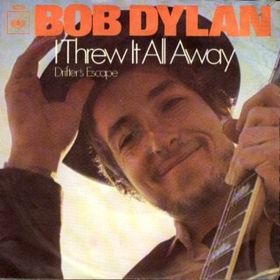
"I Threw It All Away" is a song by American singer-songwriter Bob Dylan. The track appeared on Dylan's album Nashville Skyline in 1969, and was released as its first single later that year, where it reached number 85 on the Billboard Hot 100, and number 30 on the UK Singles Chart. It is considered to be one of the best and most popular songs on the album.
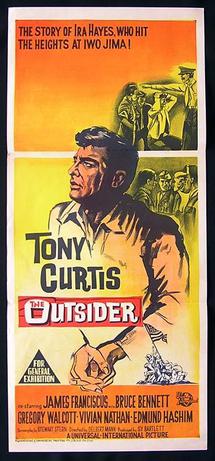
The Outsider is a 1961 biopic film about Ira Hayes, a Native American who fought in World War II in the United States Marine Corps and was one of the Marines who raised the flag on Iwo Jima. The film stars Tony Curtis as Hayes. It was directed by Delbert Mann.

Rolling Thunder Revue: A Bob Dylan Story by Martin Scorsese is a 2019 American pseudo-documentary film, composed of both fictional and non-fictional material, covering Bob Dylan's 1975 Rolling Thunder Revue concert tour. Directed by Martin Scorsese, it is the director's second film on Bob Dylan, following 2005's No Direction Home. The bulk of Rolling Thunder Revue is compiled of outtakes from Dylan's 1978 film Renaldo and Clara, which was filmed in conjunction with the tour.
"Bad News" is a song written by and originally released by John D. Loudermilk, whose version reached #23 on the U.S. Billboard country chart in 1963.
















